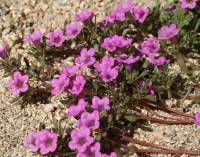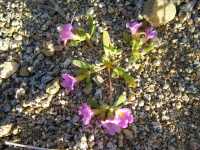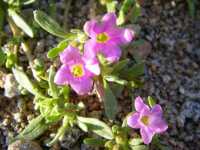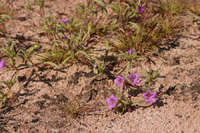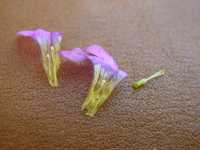Duration: Annual
Nativity: Native
Lifeform: Forb/Herb
General: Prostrate, diffusely branching annuals, fine to coarse, generally mealy-glandular 3-20 cm.
Leaves: Confined to compact clusters at tips of branches; blades obovate to spatulate or linear-spatulate, 2-7 mm wide, 1-2.5 cm long, narrowed to petiole equal to blade, strigose and hirsute.
Flowers: Subsessile in terminal, few-flowered cymes in axils of branches; lance linear calyx lobes, 2-3 mm long, glutinous and densely hirsute; funnelform-campanulate corolla bright lavender-pink, lobes ovate, 2 mm long.
Fruits: Ovoid capsule 3-2.5 mm long, hirsutulous.
Ecology: Found mostly among chaparral on rocky slopes and along arroyos below 3,500 ft (1067 m); flowers April-July.
Distribution: UT, AZ, se CA; south to n MEX (Baja California)
Notes: Generally forming a a dense mat.
Ethnobotany: Seeds pounded in a mortar and boiled into mush.
Etymology: Nama comes from the Greek nama for spring or stream, while demissum means hanging down.
Synonyms: None
Editor: SBuckley, 2010
Plant: annual, hairs generally dense, fine to coarse, generally mealy-glandular, bases swollen; stem prostrate, forked, 3-20 cm
Leaves: cauline, generally alternate, simple; margin entire, wavy, crenate, or rolled under
INFLORESCENCE: clusters (generally terminal, leafy) or flowers solitary or paired in axils, not coiled
Flowers: corolla salverform to bell-shaped; stamens generally attached to corolla at different levels, generally unequal, portion fused to corolla generally narrowly winged; scales at filament base 0
Fruit: capsule, generally loculicidal, ovoid to elliptic; Seeds generally many, small, reddish brown, brown, black or yellow
Misc: Sandy or gravelly flats; < 1600 m.
Notes: Leaves are narrowly spatulate or obovate.Corolla is funnelform in shape.
References: Kearney & Peebles; Arizona Flora. McDougall; Seed plants of Northern Arizona. Hickman, ed., The Jepson Manual. ASU specimans.



